Florida is known for its incredibly hot and humid environment. It is because of this environment that so many lizards, including snakes, enjoy living there. In fact, snakes can be found all throughout Florida. They are not picky and will live in swampy areas, mangroves, pine forests, and even in the rivers of the state. All in all, it’s not hard to find snakes in this state. There are 45 snake species (70 subspecies) that are found throughout the state. Of these 45, there are 23 that are found in the Everglades Agricultural Area (EAA). Out of these 23 snake species, only four are known to be venomous.
As the weather up north gets colder in the winter months, the weather in Florida also starts to change. This is especially true in the northern parts of Florida. There is a far greater chill factor in northern Florida than anywhere in the Keys or in southern Florida. As the temperatures lower in northern Florida, somewhere below about 60°F, many snakes up there will begin to brumate. However, in South Florida, snakes are much less likely to brumate. Instead, they are more likely to seek temporary shelter when the temperatures begin to drop to the low 40s and lower.
Even if these snakes in the south do brumate, it is only for a short time period. That’s why it is so important to know which snakes remain active in Florida during the wintertime. Learn about these 10 snakes that are active during Florida’s winters as well as other fascinating facts about them.
1. Rim-Rock Crowned Snake
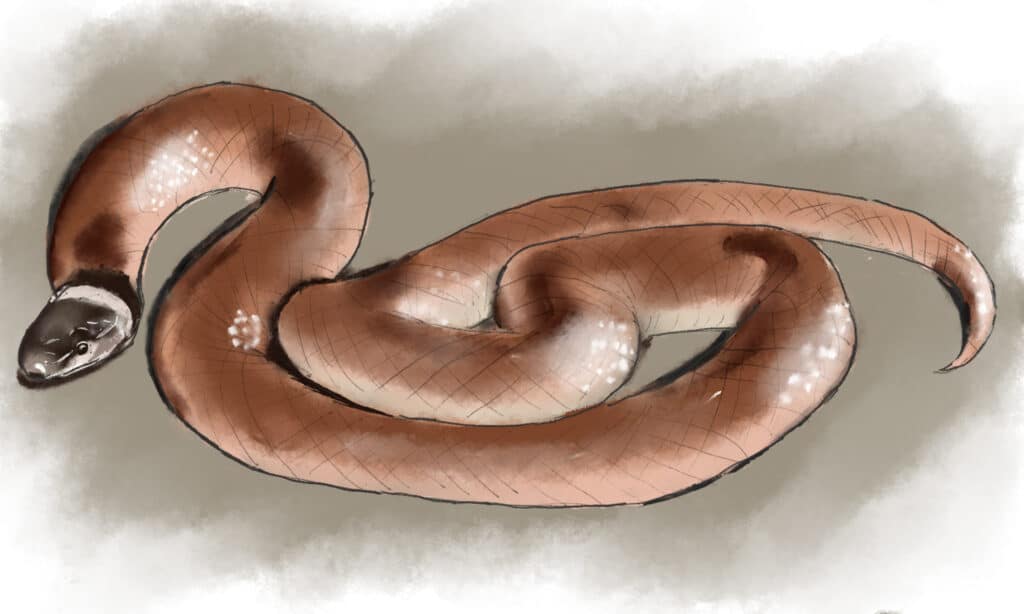
The rim-rock crowned snake is a non-venomous species that is found in south Florida. Specifically, this species can only be found in Miami-Dade County, Monroe County, and in the Florida Keys between Key Largo and Key West. They have a pretty unique appearance thanks to their pinkish-brown body and their dark black or light brown heads. These snakes also have quite tiny eyes and the color of their snout top is usually a much lighter color than the rest of their head. This nonvenomous tends to grow anywhere between seven to nine inches in length. According to the Endangered and Threatened Species Rule of Florida, the rim-rock crowned snake is a state-designated threatened species.
2. Florida Kingsnake
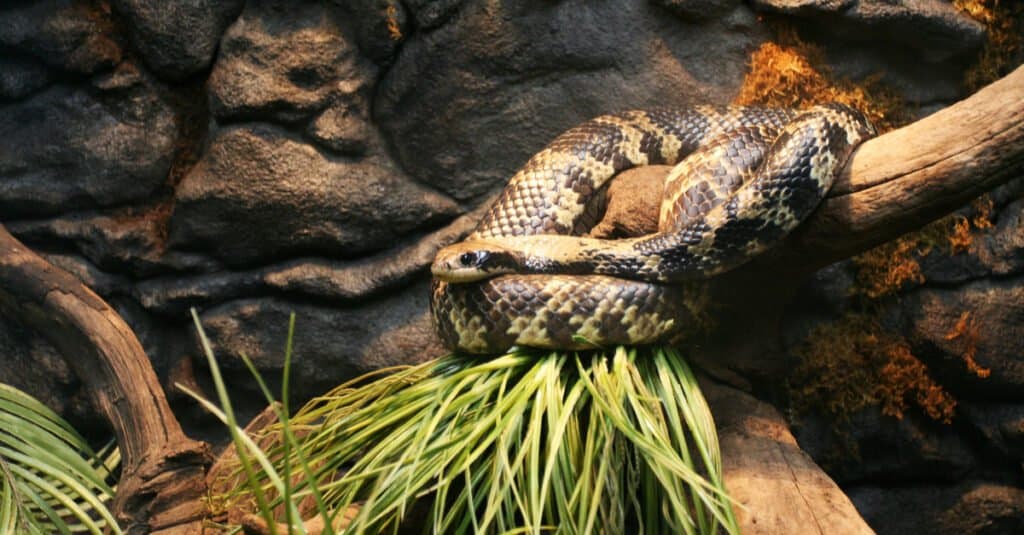
The kingsnake is one of the most widespread snakes in the
United States
.
©David Huntley Creative/Shutterstock.com
When it comes to their habitat, Florida kingsnakes can be found in great numbers south of Taylor County and throughout the Florida Keys. In terms of size, this snake species can grow anywhere between 36 and 48 inches on average. This snake can also be found in a variety of colors. They can be brown or even yellow. Another fascinating fact about them is that there have been reports of these kingsnakes mating with eastern kingsnakes (Lampropeltis getula) in the more northern parts of their habitat. You’ll also be happy to learn that this species of snake is typically nonvenomous and they rarely bite humans.
3. Eastern Ribbon Snake
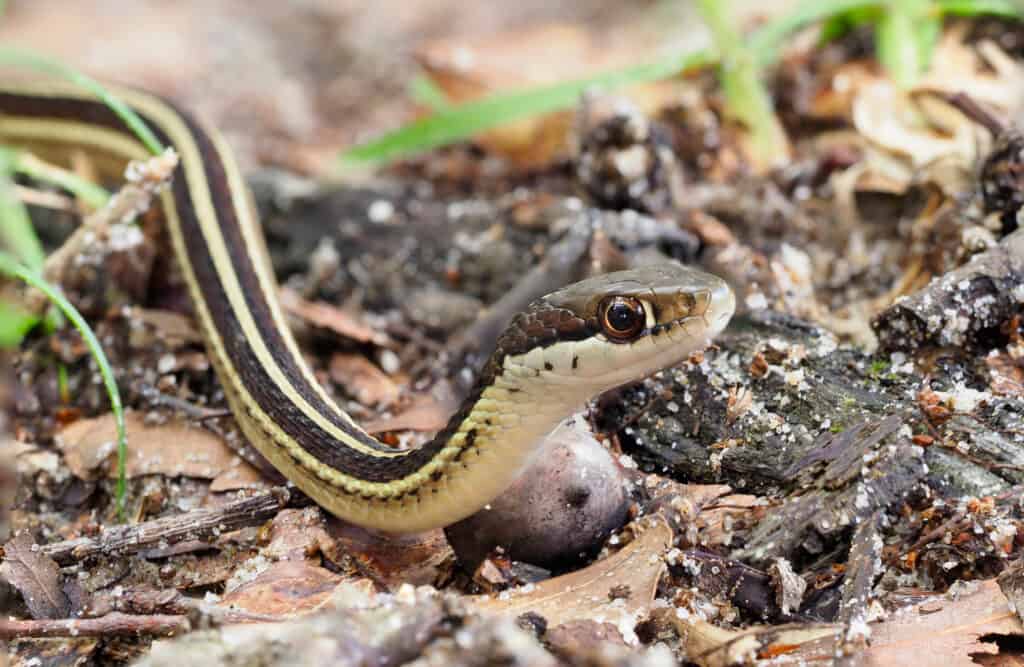
There’s only one striped snake in the Florida Keys: the eastern
ribbon snake
.
©Steve Bower/Shutterstock.com
The eastern ribbon snake is easy to spot because it has three light stripes that run down the length of its body. However, it is important to note that their base color is usually a much darker tone, anywhere from black to olive green. Their stripes however can also vary in color. Sometimes, they can be white and other times you can find them in a yellow or blue to light green color. When it comes to their size, these snakes can grow from 18 to 26 inches in length on average. These snakes look similar to garter snakes, however, they do not have venom and are not aggressive. One of the main locations where you can find these snakes are in the Florida Keys. Interestingly enough, this is the only striped snake that you can find if you happen to visit the Keys.
4. Florida Brown Snake
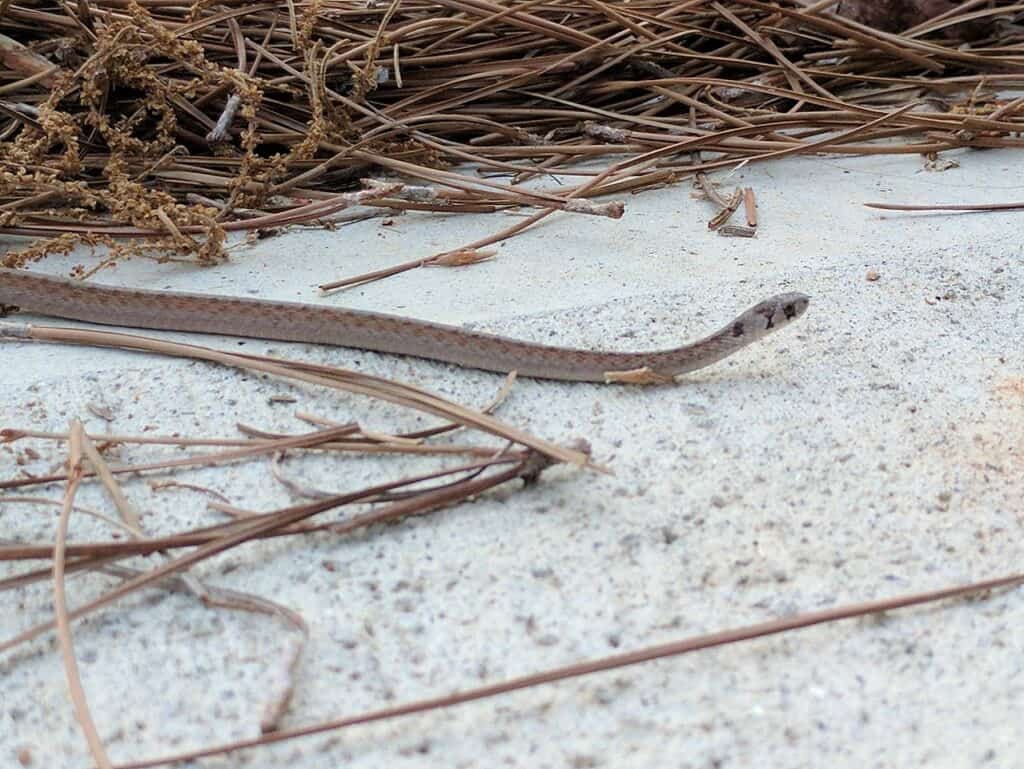
The Florida brown snake is one of its smallest species, reaching a maximum length of approximately 12 inches.
©Sreejithk2000 / Creative Commons – License
The Florida brown snake is a very small and thin species of snake. You can usually find them in a brown or light brown color. Sometimes they are even tan. Other notable parts of their appearance are white upper lips and a very long light line that runs down their back. They also have parallel lines of dots that run along their back as well. As these snakes are pretty small they usually only grow to about nine to 13 inches. They prefer living near water and in more moist and humid areas. This is why you’ll often find them hiding in between water hyacinths. Their diet consists of lots of insects, earthworms, and also the occasional slug. This snake is most commonly found in the upper portions of the Florida Keys, but you can also find them on Florida’s east coast north of Duval County.
5. Rough Green Snake
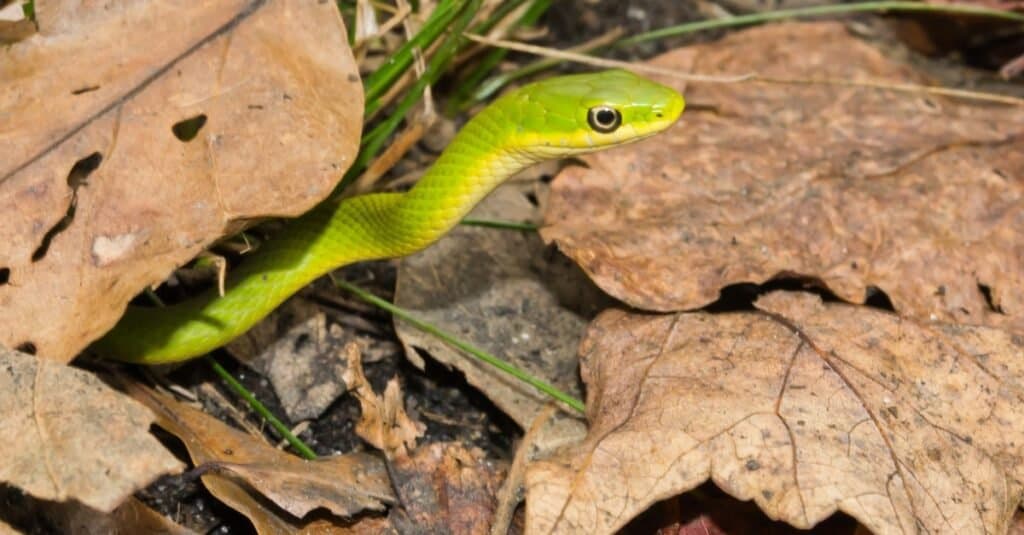
Rough green snakes can reach lengths of 46 inches, making them quite long.
©iStock.com/BobMcLeanLLC
A rough green snake is a non-venomous snake that you can instantly recognize thanks to its long, slender body and its bright green coloring. Another name for this snake happens to be the green whip snake. As you can tell, it is their marvelous green color that gives them their name. They also have yellow or tan bellies that allow them to blend into bushes which is where they primarily hide in search of prey. These gorgeous snakes are known to chow down on lots of different insects including caterpillars, grasshoppers, and crickets. Sometimes, if they’re feeling up to it, they’ll even eat small frogs, spiders, snails, and even moths. This is a larger snake so it is able to grow anywhere from 14 to 33 inches in length. These non-venomous snakes can be found primarily in the Keys as well as near the barrier islands near the coast.
6. Florida Cottonmouth
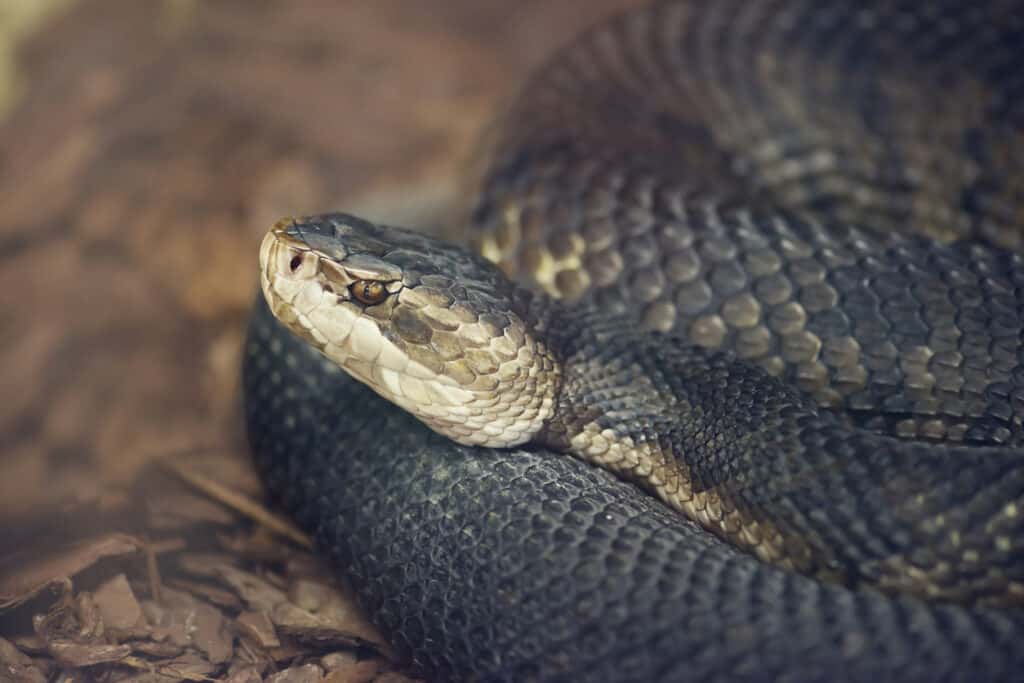
A
cottonmouth
snake lives mostly near water and is highly venomous.
©iStock.com/Saddako
The Florida cottonmouth, also known as the water moccasin, gets its name from the bright white color of the inside of its mouth. In fact, when this snake feels cornered, it is known for opening its jaw big and wide in order to display its mouth in aggression. Their appearance is well-known because they have either brown or black bands that surround their bodies. However, they get darker which age, which leaves them with a mostly black appearance.
These snakes happen to grow anywhere between 30 to 48 inches in length. This is definitely not a small snake by any means! Even though they’re not known to be aggressive, they are venomous. As we mentioned above, they will also attack if they feel encroached upon. In Florida, you can find cottonmouths just about anywhere. In fact, they are even found on nearshore islands. As a snake, they are also classified as carnivores. They will eat a variety of animals, such as fish, frogs, small mammals, and even other snakes. They have even been known to eat dead animals.
7. Eastern Diamondback Rattlesnake
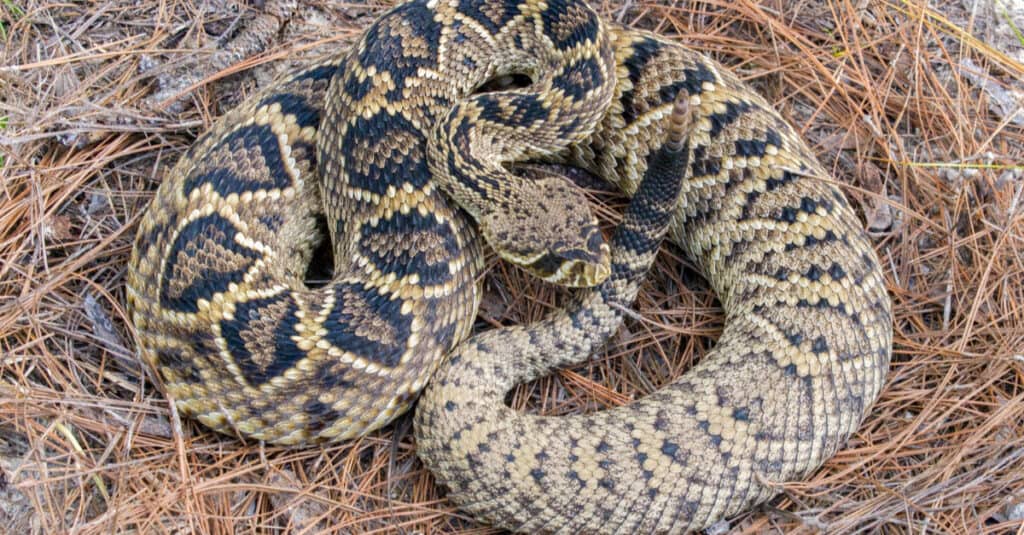
A species of pit viper, the eastern diamondback
rattlesnake
can be found throughout Florida.
©Chase D’animulls/Shutterstock.com
The eastern diamondback rattlesnake is a pretty well-known southern snake. You can find this slithery rattlesnake in Texas and many other southern states, which includes Florida. This is a pretty big snake. They have big, thick bodies that sport their signature diamond-shaped pattern that runs along their sides and the back of their bodies. If you ever get too close to one, you’ll immediately be warned by its telltale rattle sound. In Florida, every county in the state houses these snakes. There is even a decent population of them on the islands near the shores. As we mentioned, these are pretty big snakes and they can grow anywhere from 33 to 72 inches in length. They are also one of the most venomous snakes that you can come across in the state of Florida. This is definitely one snake whose path you don’t want to cross.
8. Eastern Coral Snake
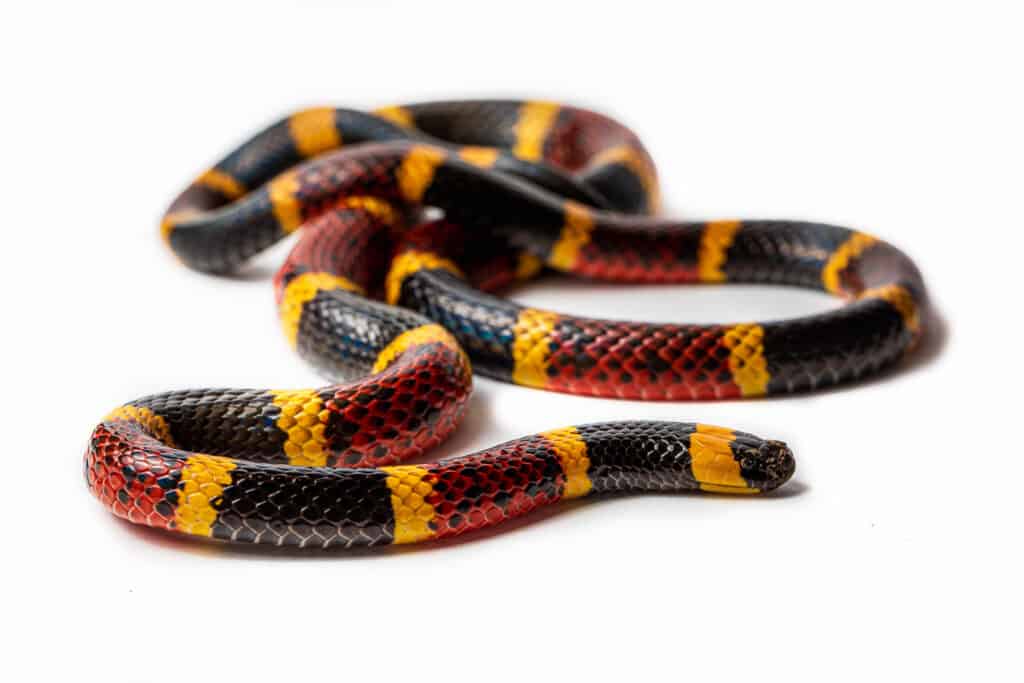
These coral snakes can be found all throughout Florida, including the Keys.
©Scott Delony/Shutterstock.com
As far as dangerous snakes are concerned, this is another one that you should avoid if you’re living in the southern parts of Florida, as they will most likely not be brumating. Eastern coral snakes, also known as harlequin coral snakes, is a venomous snake that is known to bite when they feel cornered. However, one of the trickiest things about this snake is that it is often mistaken for its non-venomous “twin” the king snake. The best way to recognize the difference is to remember that a coral snake has a very thin body that is covered with red and black bands that are separated by thin yellow rings.
The following rhyme, “Red touching black, safe for Jack. Red touching yellow, kill a fellow,” is a popular anecdote for remembering which snake is which. Although this rhyme isn’t a safe bet around the world, in Florida it can help you confirm a normally-patterned coral snake. Most estimates say that this snake can grow to a length of anywhere between 20 to 30 inches on average. You’ll find them throughout all the counties in Florida, as well as in the nearshore islands and the Florida Keys.
9. Southern Black Racer
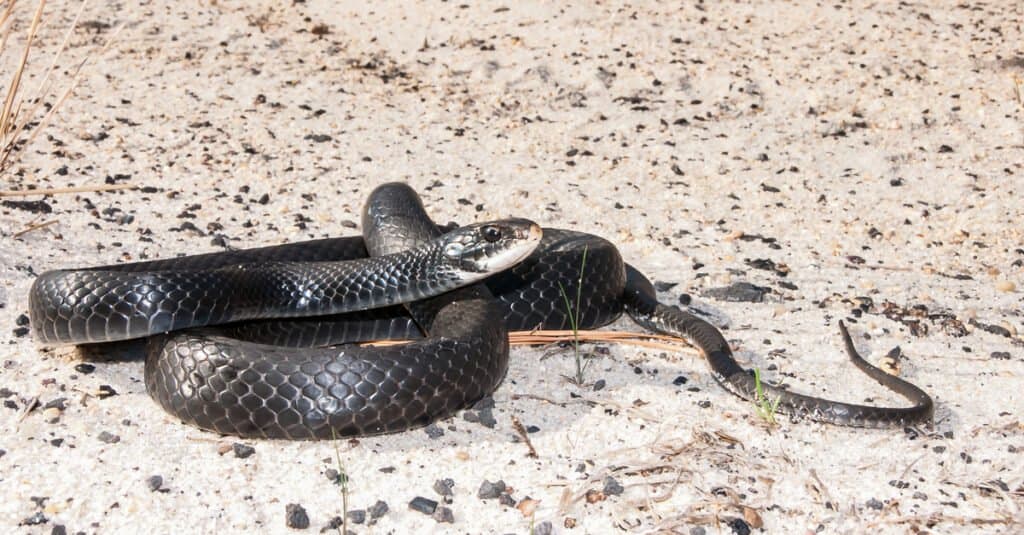
In mainland Florida and the Florida Keys, there is a large population of southern black racers.
©Jay Ondreicka/Shutterstock.com
The southern black racer is a snake that is known for its great speed. This fast and nonvenomous snake, however, is very capable of biting you if you come too close. This snake happens to love a wide variety of different habitats to call home. They can easily live in higher altitudes in the wild and they are also comfortable in agricultural areas. In terms of their diet, this snake is known to eat lots of insects, other snakes, and different types of vertebrates.
It is easy to recognize this snake because it is usually either a full black or gray color with a white chin. However, it is important to know that when they are juveniles they do have maroon splotches on them. In the Everglades, there are times when their color is more grayish brown and sometimes they even have a bluish tint. The eye colors of this species also vary depending on where they are in the state. The southern black racer that lives more inland will have a more red iris, whereas the Everglades species may have an orange or yellow iris.
Up Next…
- Where Do Snakes Go In The Winter?
- Do Snakes Come Out in The Snow?
- Do Snakes Hibernate?
- Brumation vs. Hibernation: What Are the Differences?
The photo featured at the top of this post is © iStock.com/Wide-River-Rick
Discover the "Monster" Snake 5X Bigger than an Anaconda
Every day A-Z Animals sends out some of the most incredible facts in the world from our free newsletter. Want to discover the 10 most beautiful snakes in the world, a "snake island" where you're never more than 3 feet from danger, or a "monster" snake 5X larger than an anaconda? Then sign up right now and you'll start receiving our daily newsletter absolutely free.
Thank you for reading! Have some feedback for us? Contact the AZ Animals editorial team.






